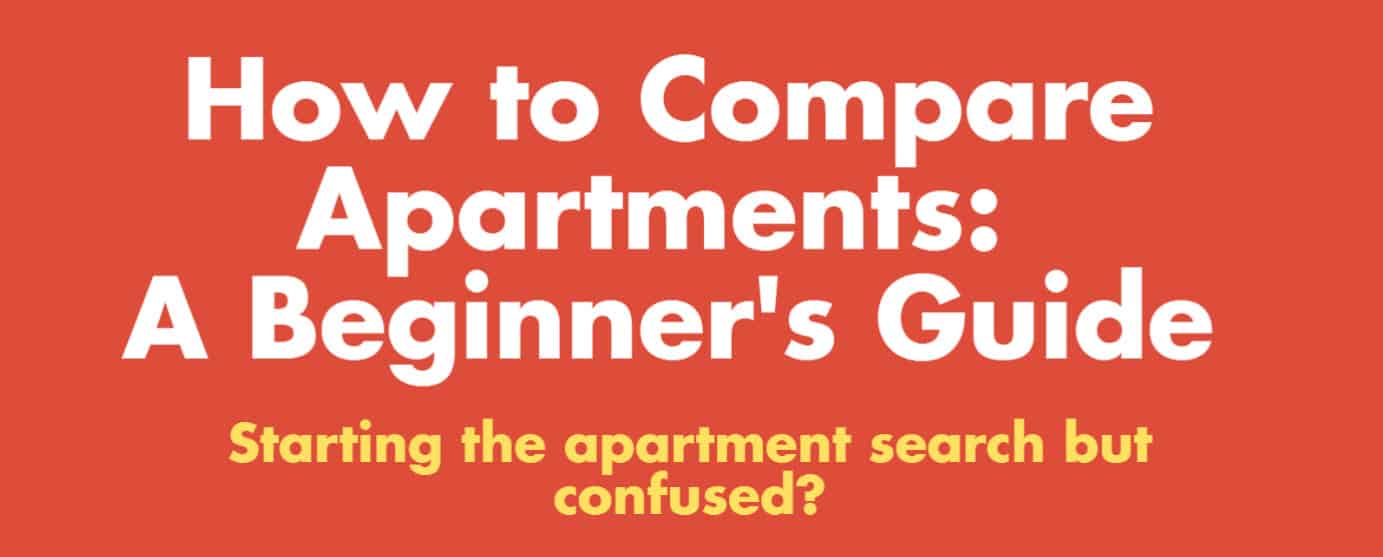Are you starting an apartment search? Are you overwhelmed with options, feature sets, and amenity lists?
You’re not alone. Most people do not have an effective way to compare apartments. We have a methodology that we’ve refined over the years. It suggests taking into consideration 5 general categories of information when you’re comparing apartments. These categories are:
- Value / Price
- Affordability
- Location
- Lifestyle
- Reputation
We have combined these five considerations into an apartment comparison tool (infographic) and a three-part series of blog posts that help you compare apartment options and come up with a decision that will best fit your needs and lifestyle.
This first article (Part I) of our guide deals with value and shows you how to do a rent comparison.
Rental Quotes
There are a myriad of ways that rents can be quoted. If you look at rent quotes across different apartment buildings, you will see some rents include all utilities, others include only some utilities (i.e. only electric and water), and yet still some do not include any utilities. So how do you compare the prices? Here is a simple step-by-step way to compare rents.
First, it’s best to compare rents apples to apples, meaning compare rents according to how much you will be expected to pay per square foot of space you’re given to occupy. The best way to do that is to compare ‘rent per month per square foot.
Don’t be intimidated. This is really quite easy to do. We just need to figure out the true net base rent of your apartment (i.e. the cost of your apartment less any utilities).
Follow these simple steps:
STEP 1:
Make sure you compare apartments of the same unit type (i.e. one bedroom/one bath to one bedroom/one bath). Write down the monthly rent and square footage of the units you’d like to compare. Examples below.

STEP 2:
Write down the utilities that are included in each. Let’s assume that for West Mill and The Lofts, the utilities are as follows:
-
- West Mill – Gas (extra), Water (extra), Electric (extra)
- The Lofts – Gas (extra), Water (extra), Electric (included)
STEP 3:
Identify the approximate value for the included utilities. Tip: You can get a rough estimate simply by looking at what other apartments in the area are charging.
For example, we estimate that living at The Lofts would cost about $75 per month for electric.

STEP 4:
Next, subtract the sum of the included utilities from monthly rent
-
- West Mill – $1,000 less included utilities ($0) = $1,000
- The Lofts – $1,400 less included utilities ($75) = $1,325
STEP 5:
Divide this new true base rent comparison by the total square footage of each unit to get a cost per square foot comparison.
-
-
- West Mill – $1,000 divided by 800 = $1.25 per sq. foot
- The Lofts – “ $1,325 divided by 1200 = $1.10 per sq. foot
-
When we compare apartment rents with this systematic approach, we see that The Lofts (listed at $1,400) is actually more cost-effective per dollar than West Mill (listed at $1,000).
Pro Tip [Advanced]:
There are more sophisticated formulas and approaches to use, but this should give you a great foundation. For example, you can back into to base rent (all non-utility monthly extras) that are collected by your landlord (these are things like: parking fees, management fees, and activity fees). We call these Non-Utility Extras. No deduction to rent should be made if these fees do not exist (i.e. are included). If you stop and think about it, this makes sense. If some landlords are collecting money for items that other landlords are including, we should add those fees to the base rent in order to compare apples to apples. The formula for this is:
(Apartment Rent – Included Utilities + Non-Utility Extras)/Square Feet = Cost Per Square Foot
In the same scenario above, if West Mill charged $50 per month for Parking and The Lofts did not charge anything, the results:
West Mill -> $1,000 less included utilities ($0) plus Non-Utility Extras ($50) = $1,050
The Lofts -> $1,400 less included utilities ($75) plus Non-Utility Extras ($0) = $1,325
With this approach, we see West Mill becomes increasingly expensive. Applying the final step of the formula and dividing the results by square footage:
West Mill -> $1,050 divided by 800 = $1.31 per sq. foot
The Lofts -> $1,325 divided by 1200 = $1.10 per sq. foot
Know someone who can benefit from this advice? Check out our friendly visual on the basics below.
How To Compare Apartments Infographic
There is more to comparing apartments than just comparing financial value. Check out Part II – How To Compare Apartments Based on Affordability






